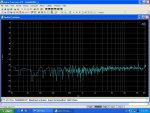Got one of these, scratch and dent for about $230... also have a few Peavey IPR 3000's on the way. I needed amps to replace Carvin 2.0's in stereo in a small stage monitor setup. A club I tech has 2 Carvers running PAS SW 1.2 15" coaxials and VM 1.2 12" coaxials. It is a simple monitor from FOH setup with a DBX 31 band graphic on each mix. For those familiar with the Carvers they are workhorse+ amps...I have 12 in service at the moment for all my portable club systems.
The club was a great Setup for comparison as I could just switch out the amp with all else remaining the same.
I replaced the mix 1+2 Carver directly with the Inuke 3000. Fired it up and it worked fine.
Band was a drum/bass/guitar with 3 vocals playing 80's rock/metal. heavy vocal mixes.
Mix 1 was a single VM 1.2-8 ohms, and mix 2 was 2 SW 1.2 in parallel- 4 ohms. The band was loud and the monitors were loud enough to be audible from FOH during sound check.
Summary, the Inuke worked all 3 sets, seemed to have plenty of gas for this setup and the mixes remained clear and present the whole night. My other concern was heat...the Carvers can get hot and I usually let them run after a show to let the fans cool down the internals. Right after the encore, Quiet Riot's Metal Head, I ran to the stage to check the amps temperature. The fan was blowing cold air and all amp surfaces were as cool to the touch as when I turned it on.
Overall success for this application. I will try this amp and other lightweights on a variety of boxes in the next few weeks.
I am hoping to put together both monitor and FOH setups that I can easily hand carry in for smaller gigs where larger racks are awkward and load in is difficult and/or long. I do a bit of hotel ballroom shows and the logistics are many times less than optimal. The testing on sub duty will tell the tale.
The club was a great Setup for comparison as I could just switch out the amp with all else remaining the same.
I replaced the mix 1+2 Carver directly with the Inuke 3000. Fired it up and it worked fine.
Band was a drum/bass/guitar with 3 vocals playing 80's rock/metal. heavy vocal mixes.
Mix 1 was a single VM 1.2-8 ohms, and mix 2 was 2 SW 1.2 in parallel- 4 ohms. The band was loud and the monitors were loud enough to be audible from FOH during sound check.
Summary, the Inuke worked all 3 sets, seemed to have plenty of gas for this setup and the mixes remained clear and present the whole night. My other concern was heat...the Carvers can get hot and I usually let them run after a show to let the fans cool down the internals. Right after the encore, Quiet Riot's Metal Head, I ran to the stage to check the amps temperature. The fan was blowing cold air and all amp surfaces were as cool to the touch as when I turned it on.
Overall success for this application. I will try this amp and other lightweights on a variety of boxes in the next few weeks.
I am hoping to put together both monitor and FOH setups that I can easily hand carry in for smaller gigs where larger racks are awkward and load in is difficult and/or long. I do a bit of hotel ballroom shows and the logistics are many times less than optimal. The testing on sub duty will tell the tale.
Last edited:




